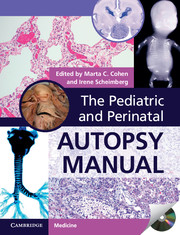Book contents
- Frontmatter
- Contents
- List of contributors
- Foreword
- Preface
- Acknowledgments
- 1 Perinatal autopsy, techniques, and classifications
- 2 Placental examination
- 3 The fetus less than 15 weeks gestation
- 4 Stillbirth and intrauterine growth restriction
- 5 Hydrops fetalis
- 6 Pathology of twinning and higher multiple pregnancy
- 7 Is this a syndrome? Patterns in genetic conditions
- 8 The metabolic disease autopsy
- 9 The abnormal heart
- 10 Central nervous system
- 11 Significant congenital abnormalities of the respiratory, digestive, and renal systems
- 12 Skeletal dysplasias
- 13 Congenital tumors
- 14 Complications of prematurity
- 15 Intrapartum and neonatal death
- 16 Sudden unexpected death in infancy
- 17 Infections and malnutrition
- 18 Role of MRI and radiology in post mortems
- 19 The forensic post mortem
- 20 Appendix tables
- Index
- References
4 - Stillbirth and intrauterine growth restriction
Published online by Cambridge University Press: 05 September 2014
- Frontmatter
- Contents
- List of contributors
- Foreword
- Preface
- Acknowledgments
- 1 Perinatal autopsy, techniques, and classifications
- 2 Placental examination
- 3 The fetus less than 15 weeks gestation
- 4 Stillbirth and intrauterine growth restriction
- 5 Hydrops fetalis
- 6 Pathology of twinning and higher multiple pregnancy
- 7 Is this a syndrome? Patterns in genetic conditions
- 8 The metabolic disease autopsy
- 9 The abnormal heart
- 10 Central nervous system
- 11 Significant congenital abnormalities of the respiratory, digestive, and renal systems
- 12 Skeletal dysplasias
- 13 Congenital tumors
- 14 Complications of prematurity
- 15 Intrapartum and neonatal death
- 16 Sudden unexpected death in infancy
- 17 Infections and malnutrition
- 18 Role of MRI and radiology in post mortems
- 19 The forensic post mortem
- 20 Appendix tables
- Index
- References
Summary
Introduction
The causes of stillbirth are varied. Stillbirth may be due to obstetric conditions such as premature labor, fetal abnormalities, infections, intrapartum complications, placental and cord factors, maternal conditions, or drugs. A significant number remain unexplained despite a full investigation [1,2]. The rate of stillbirth in the developed world over the last 20 years has remained much the same or declined very slightly at around three per 1000 births (>28 week gestational age) using international comparisons [3]. This decline in stillbirths has not mirrored the decline in infant deaths, though this may be due to the fact that there are now more older mothers, more maternal obesity [4], and more assisted conceptions, each increasing the risk of stillbirth.
The proportion of stillbirths that are assigned to the various categories depends upon the depth of the investigation and the classification system used. The proportion that is unexplained can vary from around 15–20% with ReCoDe [5] and Perinatal Society of Australia and New Zealand (PSANZ) (e.g., WA data) [6], to 60% with some of the older classification systems. The number of unexplained stillbirths can be reduced considerably by the use of a category of growth restriction, using charts customized to the mother’s parameters and using fetal growth measures derived from ultrasound measures, all of which increase the recognition of a substantial number of growth-restricted fetuses [5]. There are now a number of different classification systems with various benefits and drawbacks [7,8].
- Type
- Chapter
- Information
- The Pediatric and Perinatal Autopsy Manual , pp. 62 - 82Publisher: Cambridge University PressPrint publication year: 2000
References
- 2
- Cited by



